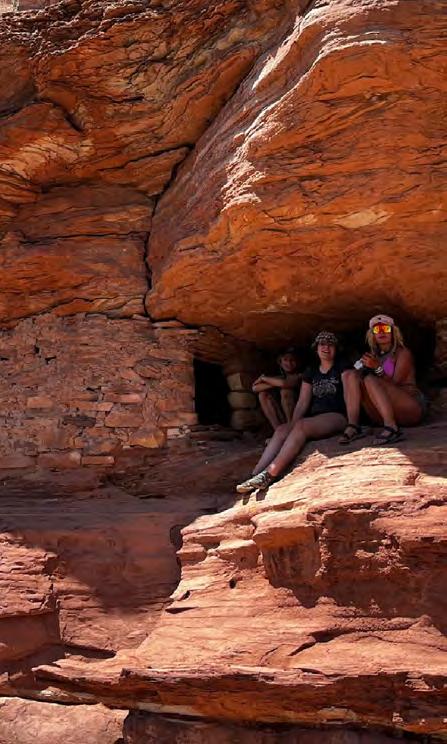
2 minute read
CONSERVING WATER IN THE WEST
from Water in the West
The Key To Survival
By Sasha Weiner
Advertisement
On the morning of our fifth day on the Green River, I sat serenely in contrast with the anger of the storm the nightbefore.Wehadgottentocamplate.Aswestarted to set up tarps, the sky started leaking, and monstrous gusts caught us by surprise. Lightning inched its way towards us in bursts. We found ourselves in a tug-of-war with the wind. As we shoved the last stakes into the ground and crawled into the safety of our big green tarps,Irealizedhowharshandunpredictablethedesert can be. One moment your skin is aching with heat and blistering from the dry air, and the next the sky has opened up. Canyons flood, rivers jump their banks, and reservoirs fill, but less water is going through the water systems in the West now. We are parching ourselves of water by overusing more of it every year. Additionally, more people are living here than ever, more than water cansupport.

Water management isn’t a new thing. In Collapse, Jared Diamond introduces a new story, but an ancient one. The Ancestral Puebloans lived in many places in the West a millennium ago, including along the Green River. The book shows how an advanced civilization can underestimate the highs and lows of the land. For Ancestral Puebloan tribes, their dense population boomed in wet years, “when more rain meant more food” (Diamond, 2005, p. 148). After a drought struck, or even just as a result of a regularly dry Southwestern climate, the environment would no longer be able to keep up with the necessities of life for tribes like the Chacoans. Their strategy was diverting water into canals that could hold immense amounts of water. (Diamond, 2005, p. 145). These strategies were not designed with disaster in mind, and the fate of the Ancestral Puebloans was to succumbtotheharshWesternconditions.
Morning after the storm
Watercolor by Sasha Weiner
May 14, 2023
In the afternoon sun of May 15th, the seventh day of our journey, we passed stonestructuressecretlynestledinthe cliffs above. Around every bend, someone would spot a new ruin to wonder about. They could have been homes, storage, or used for something unknown. Regardless of the purpose, Ancestral Puebloan people stood right where we were, thousands of years ago. I would later wonder what drove these people to survive in this bleak, dry, but beautiful place. The answer wasrightatmyfingertips:water.Water has always been the driving force of survival.
Thetribeslivinginthisareahadtoughlives. Localforests’rateofregrowthwas,“tooslow to keep up with the rate of logging”, which meantlongjourneystoneighboringforests. At their high rate of population growth, furtherexpansionwasunsustainabledueto deforestation (Diamond, 2005, p. 147). Additionally, water was scarce and droughts struck frequently. For one tribe, Diamond even writes, “The proverbial last straw that broke the camel’s back, was the drought that finally pushed Chacoans over theedge,adroughtthatasocietylivingata lower population density could have survived”(Diamond,2005,p.156).
Many parallels to this ancient disaster are obvious when examining the current water crisis throughout the Colorado River basin and the seven states that have been strugglingtodividelimitedwaterrightsina way tolerable for cities, agriculture, and the river itself. These seven states would be experiencing only seasonal water flow, and floodingwouldbeuncontrolledifitweren’t for the extensive systems, like dams and reservoirs, that control every drop of water in the West. Like the Ancestral Puebloans, we are now experiencing a drought furtheredbyhighdemand.

The Ancestral Puebloan people had diverted water for their needs thousands of years ago, and the United States did the samething100yearsago.Whentheideaof dams was introduced, it was the obvious solutiontomanagingwater.Sincethedam building boom starting in 1902, 6,575 dams have been dotted across the United States. Thedamsystemsputinplacehereareonly trumpedbythoseofChina(Hansman,2019, p. 61). Dams make desert soil farmable and desert cities survivable. With them comes widespread access to water, but also many issues. They cost the United States millions of dollars and destroy surrounding ecosystems. Some fish species are not able to swim to their spawning beds, and dams are taking a real toll on biodiversity (Hansman,2019,p.123).











